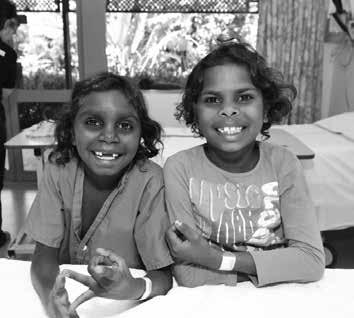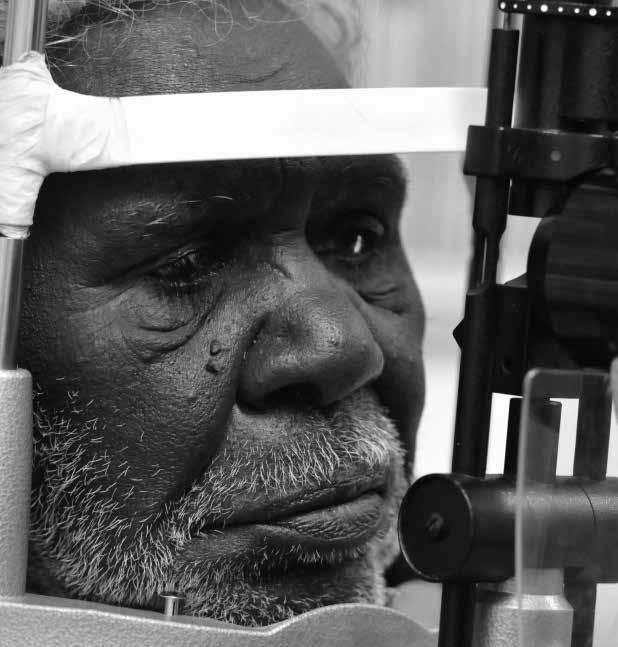
10 minute read
Vision for Health
Photo courtesy of The Fred Hullows Foundation.
The National Aboriginal Community Controlled Health Organisation (NACCHO) and the Sight For All Foundation urge Aboriginal and Torres Strait Islander people to have regular eye health checks. In Australia 75% of vision loss is preventable or treatable but for Aboriginal and Torres Strait Islander people this figure rises to 94%. Despite this staggering percentage, 35% of Aboriginal and Torres Strait Islander adults have never had an eye test. Ms Lisa Briggs, incoming CEO of NACCHO and Chair of the Vision 2020 Australia Aboriginal and Torres Strait Islander Committee said “while all Australians need to be proactive in managing their eye health, the statistics indicate Aboriginal and Torres Strait Islander people need to be particularly vigilant.” “For Aboriginal and Torres Strait Islander peoples, we should be regularly tested for eye diseases, and if you’re a diabetic you should be tested every year for your whole life cycle. Children should be tested before they start school, before high school and then as part of an adult health check. Vision loss is seen as old person’s disease but it’s not,” said Ms Briggs. James Muecke, Chairperson of the Sight For All Foundation said Diabetes is now a major cause of health complications in Aboriginal communities.
Advertisement
“Diabetes 30 years ago was almost non-existent in Aboriginal communities. But there’s been an 80 percent increase compared to mainstream non-Aboriginal population over the last 30 years and in some communities it is a serious problem. We really have to look at health and lifestyle as ways of controlling diabetes. Not only that, people need to be coming at least once a year for an eye check,” he said.
Mr Muecke said that although Diabetes is on the rise other causes of blindness have declined. “One of the big problems has been a condition called Trachoma which is an infection carried by flies. The condition is related to lack of hygiene and environmental factors but Trachoma has been on the decline for the last decade or more. In fact, in South Australia we haven’t seen a new case of blindness caused by Trachoma in over a decade. So even though there are still a few cases where people were affected by the disease years ago, we are not seeing new cases of the problem.
One of the other big problems is cataracts. One of the major issues with cataracts is that people are fearful of the operation. For a person from a remote community who has to travel to the city for the operation, it can be a frightening prospect and a number of patients will back off from having the surgery simply because they are fearful,” Mr Muecke said.
A message from the Sight For All Foundation is the importance of easing fear of having cataract surgery and regular eye checks, as well as a healthy diet, exercise, good diabetic control.
Sight For All will soon release a video that tracks the path a patient takes from their home to the clinic and to the hospital to have the operation and then home again so that future patients have a good understanding before going ahead with the surgery.
Similarly, The National Aboriginal Community Controlled Health Organisation has released an eye health DVD, Our Eyes Our Journey, funded by The Fred Hollows Foundation and developed by the Victorian Aboriginal Community Controlled Health Organisation in collaboration with Oxfam and Vision 2020 Australia.
The video promotes key eye health messages and can be viewed on the NACCHO website.
Ms Briggs is encouraging people to look online at the NACCHO website and Health Info Net to find out about Aboriginal eye health issues and use available recourses.
“Prevention and education is the key, there is a lot of goodwill and intent happening at a grass root level. If we demystify the process and if we get our eyes tested regularly then we can close the gap on vision,” Ms Briggs said.
www.healthinfonet.ecu.edu.au nacchocommunique.com www.sightforall.org

Photo courtesy of The Fred Hullows Foundation.
Diabetes
Diabetes is our nation’s fastest growing chronic disease and unless action is taken now, it expected to overtake heart disease and cancer to become the largest cause of disability and premature death in Australia.
The good news is that type 2 diabetes can be prevented through positive lifestyle changes. In fact, the risk of developing type 2 diabetes can be reduced by up to 60% by maintaining a healthy weight, being physically active and following a healthy eating plan. Cataract
A cataract is a mostly degenerative condition in which the lens of the eye clouds over, obstructing the passage of light to cause vision loss and, potentially, blindness. • Cataract caused one-third (32%) of blindness in Aboriginal and Torres Strait
Islander adults.
• About 65% of people with cataract had been operated on. Eye injury, smoking, heavy drinking, too much sun exposure and diabetes can increase the risk of getting cataracts.
Early detection
Diabetes is a condition that cannot be ignored, but sadly, there are many people within our community that have diabetes without knowing it.
In fact, it is estimated that for every diagnosed case of type 2 diabetes, there is another that goes undiagnosed and untreated. Diagnosis and appropriate management is paramount: research has shown that if people with diabetes can manage their diabetes well, the risks of complications are greatly reduced and may be either prevented or significantly delayed.


Above: NACCHO website video. Right: Two girls ready for an eye health check.

Trachoma
There are more cases of Trachoma in remote communities than in urban centres. During the 1970s, the Australian Government treated nearly 40,000 Australians affected with trachoma. In November 2006, the National Trachoma Surveillance and Reporting Unit (NTSRU) was established to combat trachoma among outback Aboriginal communities. Trachoma is a bacterial infection of the eye that can cause complications including blindness. This preventable disease is linked to poor hygiene and is often associated with poverty. Lack of facial cleanliness is the key factor that causes the spread of the infection that causes trachoma. Trachoma is also sometimes known as sandy blight.
Prevention
A clean face and clean environment is important to prevent Trachoma. The Australian guidelines closely follow those outlined in SAFE, the World Health Organization’s proposed form of trachoma control. SAFE stands for Surgery, Antibiotics, Facial cleanliness and Environmental improvement. The proper implementation of the full SAFE Strategy has significantly reduced trachoma in many communities.
On October 11, the Wik and Wik Way peoples won their final battle for non-exclusive native title rights to traditional lands in far north Queensland.
The consent determination was handed down at a special Federal Court hearing in the remote indigenous community of Aurukun.
The claim stems from the High Court’s landmark Wik decision in 1996, which found native title could co-exist with pastoral leases.
The Wik and Wik Way peoples were granted title to 19,672 square kilometres of land south of Weipa. It gives the claimants the right to camp, fish, hunt and conduct traditional ceremonies.
It is the final determination on the Wik and Wik Way people’s native title claim, which was first lodged in the Federal Court in 1993.
Key dates in the Wik case
• 30 June 1993
Before the enactment of the Native Title Act 1993, the Wik Peoples commenced legal proceedings for a common law declaration of their native title rights in far north Queensland. The Thayorre People cross-claimed for similar declarations in relation to land covered by the Wik claim. Part of the land claimed was subject to pastoral leases.
• 16 December 1993
The Commonwealth legislated to recognise and protect native title rights and interests through the enactment of the Native Title Act 1993. While the Act did not contain provisions extinguishing native title on all pastoral leases, the preamble to the Act stated that native title is extinguished by valid inconsistent government acts such as the grant of freehold and leasehold.
• 9 February 1994
The Wik Peoples sought an order from the Federal Court of Australia for the entire proceedings to be adjourned sine die so as to permit them to apply for a determination of native title under the Native Title Act 1993.
• 11 March 1994
Justice Drummond of the Federal
Court ordered that if they gave undertakings not to prosecute further their claims to Aboriginal title and possessory title in the Federal
Court proceedings, all the claims for
Aboriginal title and possessory title would be adjourned sine die so as to enable the Wik Peoples to apply for a determination of native title under the
Native Title Act 1993.
• 23 March 1994
The Wik Peoples gave such an undertaking and the following day applications for a determination of native title and compensation were lodged with the National Native
Title Tribunal.
• 29 January 1996
Justice Drummond held that the grant of pastoral leases had necessarily extinguished any native title that the Wik and Thayorre Peoples may have had on pastoral lease land. These findings were appealed to the Full Court of the Federal Court and removed to the High Court.
• 8 October 1996
The Howard Government released amendments to the Native Title Act 1993 – based on the assumption that pastoral leases extinguish native title.
• 23 December 1996
The High Court hands down its decision in the Wik Peoples v
Queensland. The Court by a 4-3
Majority held that pastoral leases do not necessarily extinguish any native title interest that may have survived, but that where there is conflict between native title rights and interests and the rights of pastoralists, the latter prevail.
The Court did not decide on the existence and nature of any native title rights the Wik and Thayorre
Peoples might have, referring this matter back to the Federal Court.
Source: Hunter, Philip (1997) The Wik Decision: Unnecessary Extinguishment, in Hiley, Graham (1997) The Wik Case, Issues and Implications, Butterworths, Sydney.
Study into the homeless away from home in South Australia
A new study into the nature and extent of seasonal homelessness experienced by Aboriginal people moving between remote communities in South Australia was released last month.
The University of South Australia’s Centre for Rural Health and Community Development surveyed Indigenous travellers in Ceduna and Port Augusta to find out their reasons for travel, how long they planned to be away from home, and how often they visited.
The researchers collected a range of data from Indigenous travellers, including the time of visit, frequency of visits and length of stay, gender, age, employment status and usual place of residence.
They found:
• There were more than twice as many male as female participants.
• In Ceduna, most participants were over 50 years old, whereas in Port
Augusta participants were primarily under 40 years of age.
• Most participants, particularly older people and couples, were on circular trips between home communities and regional centres.
• Most participants intended their trip to be between one and three weeks, although a smaller group intended to stay at least three months.
• There were no first-time travellers among the participants.
The project also raised awareness of the difficulties associated with improving local data collections in rural and remote locations.
Minister for Housing and Homelessness Brendan O’Connor said “Indigenous people in remote communities frequently travel to towns and cities for health, education and employment services, leisure, judicial requirements, seasonal conditions or safety,”
“These movements often lead to people being ‘homeless away from home’, and can put pressure on housing, social and education services in regional centres not expecting their arrival.”
“The Government welcomes this research, which provides an important insight into a largely unknown client group,” Mr O’Connor said.
The report is available at http://homelessnessclearinghouse. govspace.gov.au/whats-new-3/ research-release-homelessaway-from-home-understandinghomelessness-patterns-arising-fromthe-seasonal-mobility-of-aboriginalpeople-to-regional-service-centresseptember-2012/
Remembering Redfern

On 10 December 1992, Prime Minister Paul Keating gave a momentous speech in Redfern Park which acknowledged the impact of European settlement on Indigenous Australians.
Have we succeeded?
Paul Keating, 10 December 1992
On this 20th Anniversary of the Redfern Speech we encourage all Australians to talk about what these words mean and where we go from here.



